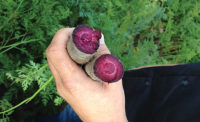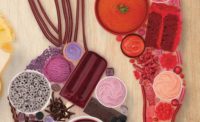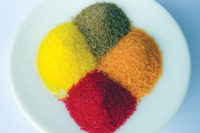Progressive Uses of Color in Food Product Development
Today's color makers are thinking outside of the box

PHOTO COURTESY OF: DDW The Color House Corp. (www.ddwcolor.com)
Since the 1970s, consumers in the US and the EU have been influenced by the publication of occasional studies purporting to link foods, food ingredients, and food additives with a variety of health concerns. We have seen food trends emerge from weak or poorly designed studies, leading to objectification of fats, salt, animal proteins, preservatives, and even methods of cooking (think: microwaves).
Two famous examples include the Feingold Diet, which arose from studies going back to 1968 that purported to link hyperactivity in children to food additives such as preservatives and synthetic colorants. In 2004, the Southampton Study purported to show the same linkages.
Table of Contents
Both sets of studies have since been discredited because of the methodologies employed, the analyses and interpretations of the results, and (in the case of the Feingold Diet) the difficulty in applying the prescribed treatment.
Because of the inherent weaknesses in these studies, regulatory agencies in the US and the EU that are charged with protecting public health and safety have generally declined to withdraw approvals or to place additional restrictions on the use of synthetic food additives, including artificial colors.
The conundrum for processors, however, is that anxious consumers continue to respond to artificial additives and colors with suspicion. On top of this, the industry is in the midst of a “clean label” trend driven largely by consumer sentiment. It is somewhat reminiscent of the low-fat, no-fat trend of the 1990s and similar fads that were based on inconclusive science, yet still triggered consumer anxiety.
Clean Colors
The clean-label trend presents numerous challenges to the food industry, as the move to “all natural,” “naturally derived,” or, more recently, GMO-free and organic-certified ingredients means a shrinking list of ingredients and additives available for formulating prepared foods.
While the industry is aware it must work to meet consumer expectations—sometimes to the point of setting aside known science—the greatest challenge is that consumer expectations can change suddenly, and not always based on good information.
Bringing new products to market is a time-consuming and costly undertaking. Today’s processors must also face the challenge of reformulating branded products, especially to remove certain ingredients and additives.

Vivid natural colors are giving a brighter look to clean-label formulations.
PHOTO COURTESY OF: Earthrise Nutritionals LLC (www.earthrise.com)
On top of this, they must do so while meeting new and increasingly detailed, disparate consumer expectations. And, once all this is done, the product must maintain the characteristics that the brand’s consumers have come to expect. To term this increasingly common paradigm “a headache” is an understatement.
These trends represent technical challenges that can bedevil the product maker, and in few areas is this truer than in the use of food colorants. For several decades, the food industry relied heavily on synthetic food colorants. Certified colorants consumers have been accustomed to seeing on labels include FD&C Red #40, Red #3, Blue #1, Blue #2, Yellow #5, Yellow #6, and occasionally Green #3.
These colorants, alone or in combination, form the basis for delivering a full spectrum of color hues in most food applications. They are relatively inexpensive to use, usually simple to incorporate into food applications, and typically predictable in their performance.
Natural replacements for synthetic colorants tend to be substantially more expensive on a cost-in-use basis. Moreover, their use can encounter many hurdles.
First, it is difficult to achieve the variety of hues the industry—and consumers—expect with only naturally derived colorants. Second, the naturally derived colorants do not always perform as predictably, or as with the same versatility, as synthetics in certain applications. It often is necessary to tune the choice of color and color delivery system to the application. Third, naturally derived colorants are more sensitive to food processing and matrix characteristics, such as pH, temperature, light exposure, and ingredient incompatibilities.
Colorful Response
Color manufacturers have responded to these challenges in several ways. Not only have new, naturally derived colorants been added to the range of available colorants in recent years, but formulation methodologies have been developed to overcome some application and performance challenges.
As better understandings of the behavior of naturally derived colorants are developed, color manufacturers can offer expanded guidance on where, when, and how these colorants can be used to achieve the desired result.
Fruit and vegetable juices and extracts are enjoying increased use for their coloring properties. In recent years, natural blues and greens from the edible blue-green algae spirulina have significantly expanded color palette possibilities. Spirulina was reviewed and approved for use by the FDA, where it has been listed with its own unique specification in 21 CFR 73.530. The product is less stable to light and heat than its artificial counterparts, and it is effective in the pH range from 4 to 8.

According to the Sorghum Checkoff board, colored sorghum is being researched not only as a source of natural food colorants but health benefits, too.
PHOTO COURTESY OF: Southern Exposure Seed Exchange (www.sorghumcheckoff.com)
Since spirulina’s approval, green colors from alfalfa extract and blues and greens from the Huito fruit (Genipa americana) also have been added to the natural color tool chest. Huito is a tropical fruit from South and Central America. When its juice is combined with watermelon juice, a blue color is obtained. This color is stable to light and heat and can be used in pH’s ranging from 2.5 to 8.0. This combination is classified by the manufacturer as a “fruit juice,” meeting the requirements of 21 CFR 73.250.
Both blue colors are of interest in the US because, until their approvals, there weren’t many options for food and beverage manufacturers seeking clean-label blue colors. Also, clean-label green colors were difficult to find because of performance problems associated with the use of chlorophyll-based colorants. The industry now has the option of mixing naturally based blue colorants with the existing naturally derived yellow colorants to achieve different shades of green.
Consumers Say
Just when a trend in the food industry seems entrenched, something happens that changes the game. As previously described, the past few years have seen many major national and global brands following the trend to commit to using only “natural” ingredients, especially colors and flavors. When the clean-label trend had fully arrived, it was clearly driven by consumer preference.
And then, General Mills Inc., shortly after a quiet switch to natural color sources for its Trix corn puff cereal, announced the reintroduction of “Classic” Trix cereal with all the previous artificial colors and flavors originally featured in the product. What happened?
Initial reports suggest that, while consumers expressed desire for the “cleaner” label of reformulated cereal, adult aficionados—having a personal history with the brand—were less than enchanted with the changes in appearance. (They also indicated a disenchantment with the flavor of the reformulated line, but this likely was a psychological perception, as the actual taste difference was negligible.)

Natural colorant preparations can present more application hurdles than their synthetic counterparts.
PHOTO COURTESY OF: Iraexist/Wikicommons (www.commons.wikimedia.org)
Classic Trix cereal is flavored with natural and artificial ingredients. Its colors—red, yellow, orange, green, purple, and blue—all are produced with synthetic (FD&C) colorants. The cleaner label version contains only naturally derived food colorants (annatto extract, turmeric extract, and fruit and vegetable juices) and only natural flavors.
It is challenging to achieve a vibrant natural blue or green color in extruded cereal products using only the naturally derived colorants permitted by the FDA, so the range of colors in the cleaner label product was limited to orange, purple, pink, and yellow. The appearances are quite different, as the naturally colored pieces are less vivid and more pastel.
Price Point
Another aspect of reformulating from artificial to natural colors is cost. While prices have been coming down on natural colorants, as with natural flavors they typically are more expensive on a cost-in-use basis than their artificial/synthetic counterparts.
The use of relatively lower color-content preparations from natural sources, derived for source material by extraction, could also impact background flavor, making it more difficult to achieve a true reproduction of the original fruity flavors. The synthetic colorants, in contrast, are made by chemical synthesis processes that ultimately produce high-purity, high-color-content food additives which contribute essentially no background flavor to the finished cereal piece.
Natural colorant preparations can contain far less active colorant than their synthetic counterparts. Synthetic preparations of color dyes can contain as much as 90% of active coloring agent, while naturally derived counterparts can contain as little as 1-10% of active coloring agent.

Natural colors, while presenting challenges, are viewed unequiv-ocally as healthier and not damaging to the environment.
PHOTO COURTESY OF: Colormaker Inc. (www.colormaker.com)
Naturally derived colorants generally cost substantially more than synthetic preparations on a pure weight basis, too. This means that the final cost-in-use could be five to 25 times as much as a synthetic alternative.
For the national—not global—manufacturer, there’s some relief in that the drive for clean label has more flexibility. In Europe, consumer sentiment to rid the food supply of synthetic ingredients is strong. Artificial colors and other ingredients are viewed unequivocally as less healthy and potentially more damaging to the environment.
Moreover, relative cost is less of a consideration against what are perceived by EU consumers as health and nutrition concerns. European grocery stores and food manufacturers are more strongly engaged in the clean-label trend as they strive to fulfill consumer demands for healthier products.
Consumers in the US acknowledge they too are concerned with health and nutrition aspects, of course, but those concerns are tempered by other motivators, including cost, flavor, appearance, and perhaps a healthy skepticism about health and nutrition claims and “sound-bite science.”
While media-inflamed scares based on incomplete or sketchy studies too often kick off fads, they can fade quickly in the face of a food culture so strongly rooted in instant gratification, comfort, and nostalgia.
Liquid Color
The soft drink industry faces a particularly hard task in terms of the use and labeling of food colorants. The traditional cola beverages that are so popular worldwide are colored with caramel colors. These colorants are produced by the controlled heating of high fructose corn syrup in the presence of food-grade acids or bases that act as catalysts for a browning reaction. This, in turn, produces the intense colors associated with food grade caramel colorants.
These additives find uses throughout the food industry, but the beverage industry is a particularly heavy user. There are numerous advantages to caramel colorants. The ingredients used to make them are inexpensive, plentiful, and easy to obtain. The basic technology for their production is relatively simple, and the cost is relatively low. This makes them ideal for many uses, and global demand is high.
However, of late there has been a downside to using caramel colors. It is embodied in California’s Proposition 65. “Prop 65,” as it is known in the industry, goes beyond FDA regulations in restricting the use of food ingredients and additives that it claims might be linked to health risks such as cancer. The rule requires warning labels on products that contain any of the listed chemicals in amounts above an established threshold.

Fruit and vegetable juices, extracts, and powders continue to enjoy increased use for their natural coloring capabilities.
PHOTO COURTESY OF: GNT USA Inc. (www.gnt-group.com)
The manufacturing process for caramel colors leads to the formation of two notable side-reaction products, 4-methyl imidazole (abbreviated as 4-MeI) and furfuryl alcohol. These substances were thought to be linked to an increased risk of cancer and therefore appear on the Prop 65 list of suspect chemicals. The legislation also provides for a threshold value below which a substance is thought to have no effect.
While a threshold has been established for 4-MeI, none has been offered for furfuryl alcohol. Caramel color manufacturers have been quick to modify their processes to reduce the level of 4-MeI in their products, but they have not been able to respond as effectively where furfuryl alcohol is concerned due to the lack of an established threshold.
The basic problem is that browning reactions seem to lead to the formation of 4-MeI and furfuryl alcohol in many, if not all, cases. Roasted coffee, grilled meat and vegetables, fried foods, and all similarly prepared foods and beverages have the potential to contain these side reaction products. This is why all the coffee shops in California have posted Prop 65 warnings.
A common refrain has been, “If there is any doubt about the safety of a food ingredient, why risk using it at all? Just eliminate it.” However, when decisions with far-reaching effects are driven by poor or incomplete understanding, the result can be at the least disruptive and at worst, counter-productive.
The result of reformulating reactively from artificial to natural colorants can be hit or miss. A marketing decision that the naturally flavored and colored product represents a higher value to the consumer and therefore can command a higher price only works when weighed against the other drivers of that particular product.
For example, Kraft Foods Inc. was successful with its minimally publicized “soft” removal of artificial color in one of its flagship product lines, Kraft Macaroni and Cheese. General Mills Inc., however, as noted above, might have done better to hold off on launching a somewhat drabber and costlier version of its popular Trix cereal.
While these calculations must be made before changing any key ingredient in a product, they are especially critical when it comes to food colorings. After all, it’s well established that we eat first with our eyes. Color is one of the first qualities we encounter in a packaged food or beverage.
Caramel Coloring Update
In 2007, concerns arose over the presence of the heterocyclic organic compound 4-methylimidazole (4-MEI) in foods and beverages, such as cola drinks, coffee beverages, dark beers, and other so-colored products, and specifically in caramel coloring.
4-MEI is not an additive; it’s formed as a byproduct during cooking, especially high-heat cooking, as in the roasting of coffee beans or in meats during roasting or grilling. In caramel coloring, it comes about as a trace impurity during the making of some forms of caramel coloring—those designated as Class III and Class IV. These are the colorings used in cola beverages and foods.

European, Asian, Canadian, and US governments and agencies investigated 4-MEI as a possible carcinogen. All these agencies concluded that the compound is safe in the amounts normally ingested. Yet, in January 2011, California declared it a carcinogen and restricted its usage.
It is possible to duplicate the appearance of caramel colors with synthetic food colorants, but not in a way that fits well with the current clean-label trend. Color manufacturers have attempted to address this issue by developing new colorant formulations using naturally derived substances and entirely different manufacturing processes.
Several recent product introductions have managed to address the issue in one way or another, with similar results. Relative to caramel colorants, they are substantially more expensive on a cost-in-use basis. This makes them undesirable in the cost-sensitive soft drink industry. Couple this with the consensus among regulatory bodies that caramel colors remain approved for use and there is little incentive to switch to newer, non-caramel additives.
Originally appeared in the April, 2018 issue of Prepared Foods as Seeing Colors.
Looking for a reprint of this article?
From high-res PDFs to custom plaques, order your copy today!






